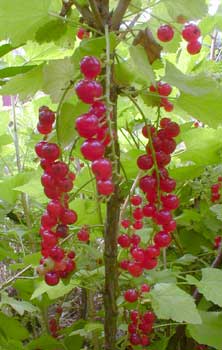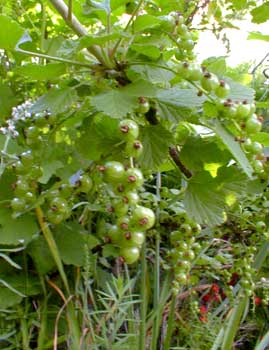
'Cherry Red'
Northern Currant
"He saw us not, though distant but few steps;
For he was busy, dealing, from a store
Upon a broad leaf carried, choicest strings
Of red ripe currants."
-William Wordsworth
(1770-1850)
(1770-1850)
The name Currant is a corruption of Corinth. It is believed that the European species must have been popular in that ancient city, so that tart miniature seedless raisins came to be widely known as "raisins de Corinthe" & in time merely Corinths, then Currants.
Ribes rubrum is the North American species. Across both sides of the Canadian border, increasing acreage is being devoted to growing currants, taking advantage of an increasing market for the fresh fruits, for dried currant raisins, & for currant jams, jellies, & specialty products.
The majority of the USA's commercial currant crops come out of eastern Washington. The choices for harvestable fruit are Red Currants, Black Currants, & Gooseberries.
To help fascilitate the currant rennaisance, the Washington State Department of Agriculture has developed & tested a particularly fruitful strain greatly suited for our region, & dubbed it 'Cherry Red.' This cultivar has larger fruits that ripen earliest in summer. Although tart, to me there is no question but that they are sweet enough to eat fresh from the shrub, & certainly are superior for canning.
 The fruit is shown at full ripeness in the first photo from July, arranged in what Wordsworth called "choicest strings." The second photo from late May shows the fruit while still green.
The fruit is shown at full ripeness in the first photo from July, arranged in what Wordsworth called "choicest strings." The second photo from late May shows the fruit while still green.This variety is also resistance to pests such as the currant borer moth (Synanthedon tipuliformis) & the currant stem girdler sawfly (Janus integer) , as well as to mildew & other diseases. The berries are of the highest quality, & 'Cherry Red' is one of the highest yield cultivars for commercial crops, making it the most popular choice for Ribes farmers from British Columbia to California.
Though developed for commercial crops, its disease resistance & fruit-laden beauty make it a darned good choice as a garden ornamental. We also have three Ribes sanguineum cultivars in choice locations in our gardens, the red-flowering 'King Edward VII'; the white-flowering 'White Icicle'; & the golden-leafed variant, 'Brocklebankii.'
We wanted one more, but for a harsher roadside location that was apt to be a bit harsh for R. sanguineaum, which can get scruffy-looking leaves if too greatly sunned or pushing the edges of drought hardiness. As the Northern Red Currant is an even hardier native wild shrub, it has proven perfect for a low-maintence spot.
Crinkly lobed leaves are aromatic when bruised. The tart late June & July berries are glassy red, shiny & transluscent (see the Northern Red Currant Page of the Berries Gallery). Self-fertile, they fruit just as well as a single shrub, unlike, say, the majority of blueberries which like to cross-pollinate between cultivars to produce the best fruits. But it may take three or four years to establish & bush out well enough to fruit to its maximum, being only thinly fruited while the root system is young.
On average R. rubrum grows four to six feet tall & two to four feet wide. It is usually grown as a multi-stemmed shrub, but could be trained as a little one-trunked miniature tree. It prefers moist humusy soil in dappled sunlight, or some protection from the strongest afternoon sun. Pruning is for appearance, to preserve compact growth, & to provide an airiness that keeps the shrub from being attacked by mildew.
Northern Red Currants are remarkably resistant to all diseases, but one worry about R. rubrum is that it is believed to be an intermediary host for white pine blister. For that reason a few states have restrictions on growing it, & it is banned in North Carolina. Where white pine forests are not an issue, then there is no need for restrictions on planting R. rubrum.